The Caesar salad is one of the most iconic salads in the world, loved for its simple yet bold flavors. Whether served as a side dish or the main course, this salad has become a staple in many households and restaurants. But have you ever wondered what exactly goes into a classic Caesar salad? This article will delve into the essential ingredients, the history of the salad, and how to make it at home, including various tips and tricks to elevate your Caesar salad experience.
Print
Classic Caesar Salad Recipe
- Total Time: 25 minutes
- Yield: 4 servings
- Diet: Vegetarian
Description
This classic Caesar salad is crisp, creamy, and packed with bold flavors. Featuring fresh romaine lettuce, homemade Caesar dressing, crunchy croutons, and Parmesan cheese, this recipe delivers a restaurant-quality salad at home. Perfect as a side dish or topped with protein for a hearty main course, this salad is a timeless favorite. The rich dressing, made with egg yolks, garlic, lemon juice, Dijon mustard, olive oil, and anchovies, creates the signature tangy and umami-packed flavor.
Ingredients
For the Salad:
- 1 large head of romaine lettuce, washed and chopped
- 1 cup homemade croutons (see below)
- ½ cup freshly grated Parmesan cheese
For the Caesar Dressing:
- 2 egg yolks
- 3 anchovy fillets (or 1 teaspoon anchovy paste)
- 2 cloves garlic, minced
- 1 teaspoon Dijon mustard
- 1 tablespoon fresh lemon juice
- ½ teaspoon Worcestershire sauce
- ½ cup extra virgin olive oil
- ¼ cup grated Parmesan cheese
- Salt and freshly ground black pepper, to taste
For the Homemade Croutons:
- 2 cups day-old bread, cut into cubes
- 2 tablespoons olive oil
- ½ teaspoon garlic powder
- ¼ teaspoon salt
- ¼ teaspoon black pepper
Instructions
Make the Croutons:
- Preheat the oven to 375°F (190°C).
- In a bowl, toss the bread cubes with olive oil, garlic powder, salt, and pepper.
- Spread evenly on a baking sheet and bake for 10-12 minutes, flipping halfway, until golden and crispy.
- Remove from the oven and let cool.
Prepare the Caesar Dressing:
- In a bowl, whisk together egg yolks, minced garlic, Dijon mustard, lemon juice, and Worcestershire sauce.
- Slowly drizzle in the olive oil, whisking constantly to emulsify the dressing.
- Stir in grated Parmesan, then season with salt and pepper to taste.
Assemble the Salad:
- Place chopped romaine lettuce in a large salad bowl.
- Drizzle the dressing over the lettuce and toss to coat evenly.
- Add the croutons and grated Parmesan, tossing gently.
- Serve immediately with extra Parmesan and freshly ground black pepper on top.
Notes
- No raw eggs? Substitute 2 tablespoons of mayonnaise for the egg yolks.
- Anchovy-free option: Use ½ teaspoon of miso paste or simply increase Worcestershire sauce.
- Make it a meal: Add grilled chicken, shrimp, or salmon for extra protein.
- Storage: Keep dressing in the fridge for up to 5 days in an airtight container.
- Prep Time: 15 minutes
- Cook Time: 10 minutes
- Category: Salad
- Method: Tossed
- Cuisine: Italian-American
A Brief History of Caesar Salad

The Caesar salad was first created in 1924 by Caesar Cardini, an Italian-American restaurateur. According to legend, Cardini invented the salad at his restaurant in Tijuana, Mexico, during a particularly busy Fourth of July weekend. He was forced to improvise with ingredients on hand, and that’s when the famous Caesar salad was born. It consisted of simple ingredients like romaine lettuce, croutons, and a homemade dressing that would later become the hallmark of the dish. The Caesar salad quickly gained popularity due to its unique combination of creamy, savory, and tangy flavors.
Today, the classic Caesar salad has evolved and can be found in almost every restaurant’s menu, from casual diners to fine dining establishments. While many variations of the salad exist, the original creation remains beloved for its simplicity and rich flavor. If you’re curious about the perfect recipe to try at home, you can explore detailed instructions from culinary experts like those on Bon Appétit’s Classic Caesar Salad.
Essential Ingredients of a Classic Caesar Salad
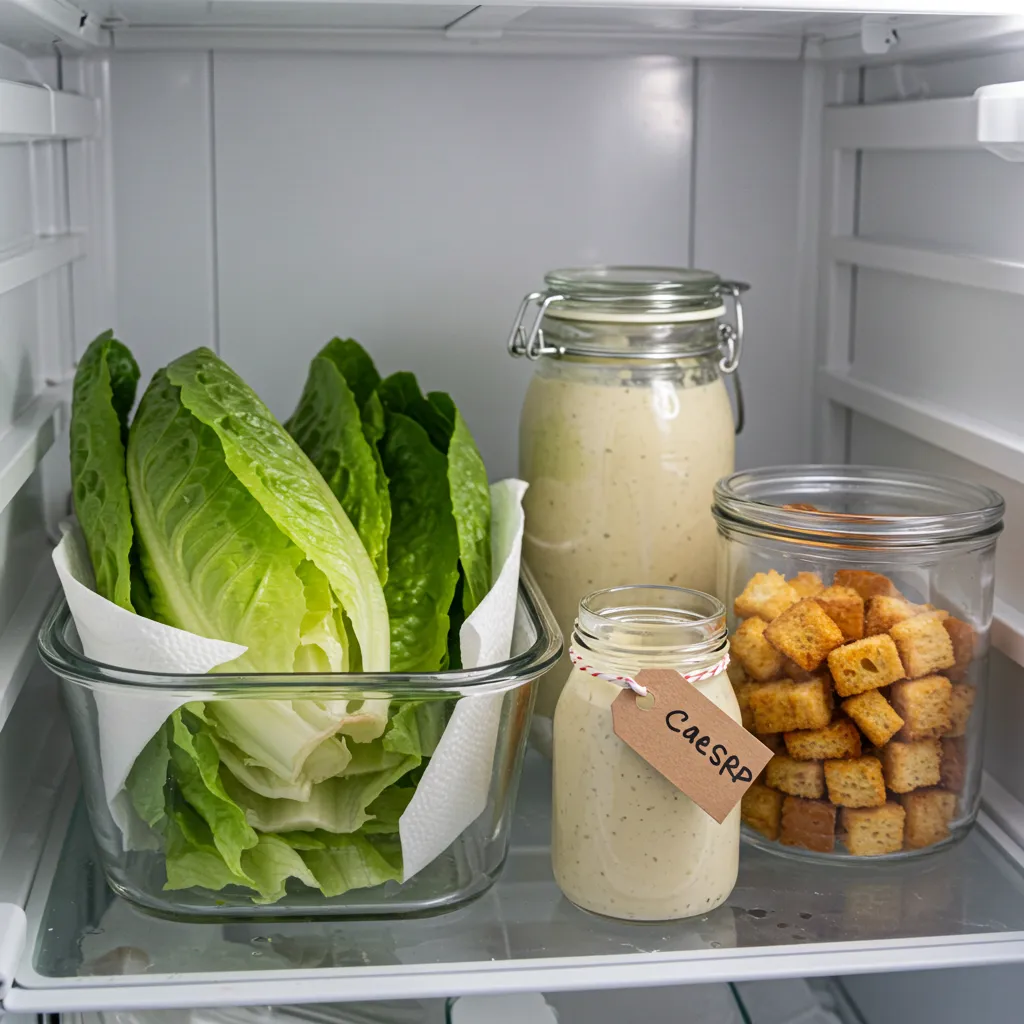
To create the perfect classic Caesar salad, you need a few key ingredients. These ingredients are what define the traditional flavor profile and make the salad a favorite worldwide. From croutons to Parmesan cheese, every component plays a role in delivering the signature Caesar salad experience.
1. Romaine Lettuce: The Foundation of the Salad
The most important ingredient in any Caesar salad is the lettuce, and for a reason: romaine lettuce. It’s not just any lettuce but a variety with crisp, long leaves that hold up well to the hearty dressing. Romaine provides a perfect crunch and a mild bitterness that balances the rich, savory dressing. This lettuce is also hearty enough to absorb the flavors of the dressing without wilting or losing texture.
Though some people may use other types of lettuce, such as butter lettuce or iceberg, romaine remains the traditional and preferred choice for a classic Caesar salad. Romaine lettuce is typically torn into bite-sized pieces and forms the base of the salad. For those who prefer a different base, the crispy, slightly bitter leaves of romaine bring the perfect contrast to the creamy and tangy dressing that defines the dish.
For a comprehensive guide on choosing and preparing romaine, see this helpful resource from The Kitchn.
2. Caesar Salad Dressing: The Heart of the Flavor
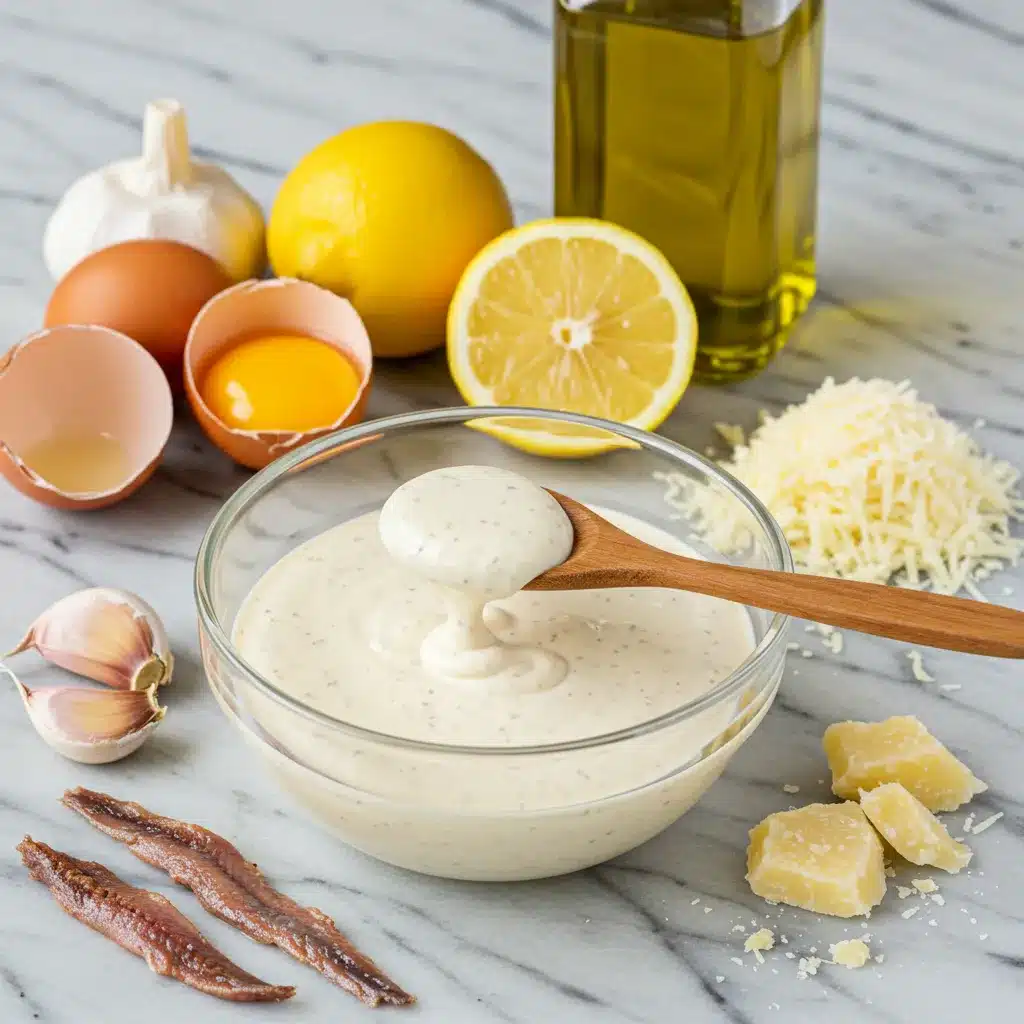
The Caesar dressing is undoubtedly the heart and soul of this iconic salad. The dressing is rich, creamy, and tangy, providing the perfect balance to the crisp romaine lettuce and crunchy croutons. Classic Caesar dressing is made with a base of egg yolks and olive oil, which provide the creamy texture and richness. But the real secret to its depth of flavor lies in the addition of anchovies (or anchovy paste), garlic, mustard, lemon juice, and Parmesan cheese.
- Egg yolks contribute creaminess and stability to the dressing.
- Garlic brings a robust, savory flavor.
- Mustard and lemon juice add a slight tang and balance the richness of the egg yolks and olive oil.
- Parmesan cheese gives the dressing a savory, umami flavor that enhances the other ingredients.
- Anchovies, or anchovy paste, provide that signature salty and umami-packed flavor that defines the salad’s distinct taste.
If you want to make this dressing at home, the Food & Wine website has a detailed recipe to guide you. Alternatively, if you’re in a rush, store-bought dressings are available, though homemade is always the best option for flavor.
What is the original Caesar dressing made of?
The original Caesar dressing was made with egg yolks, anchovies, garlic, Parmesan cheese, lemon juice, and olive oil. These ingredients come together to form a creamy, tangy, and umami-rich dressing that makes the salad stand out. The anchovies are essential, as they provide the distinct salty flavor that balances the rich, creamy texture of the dressing.
3. Croutons: Adding Crunch to the Salad
No Caesar salad is complete without croutons. These small, crispy cubes of bread add much-needed crunch and texture to the dish. The croutons soak up the Caesar dressing while retaining their crispy exterior. Homemade croutons are easy to prepare—just cube some day-old bread, toss it with olive oil, garlic powder, and salt, and bake until golden brown.
While you can certainly buy pre-made croutons, homemade croutons elevate the flavor and texture of your Caesar salad. In fact, many people agree that the best Caesar salad recipes are those made with freshly baked croutons. These croutons not only provide texture but also absorb some of the dressing, creating a rich, flavorful bite.
4. Parmesan Cheese: A Rich and Savory Addition
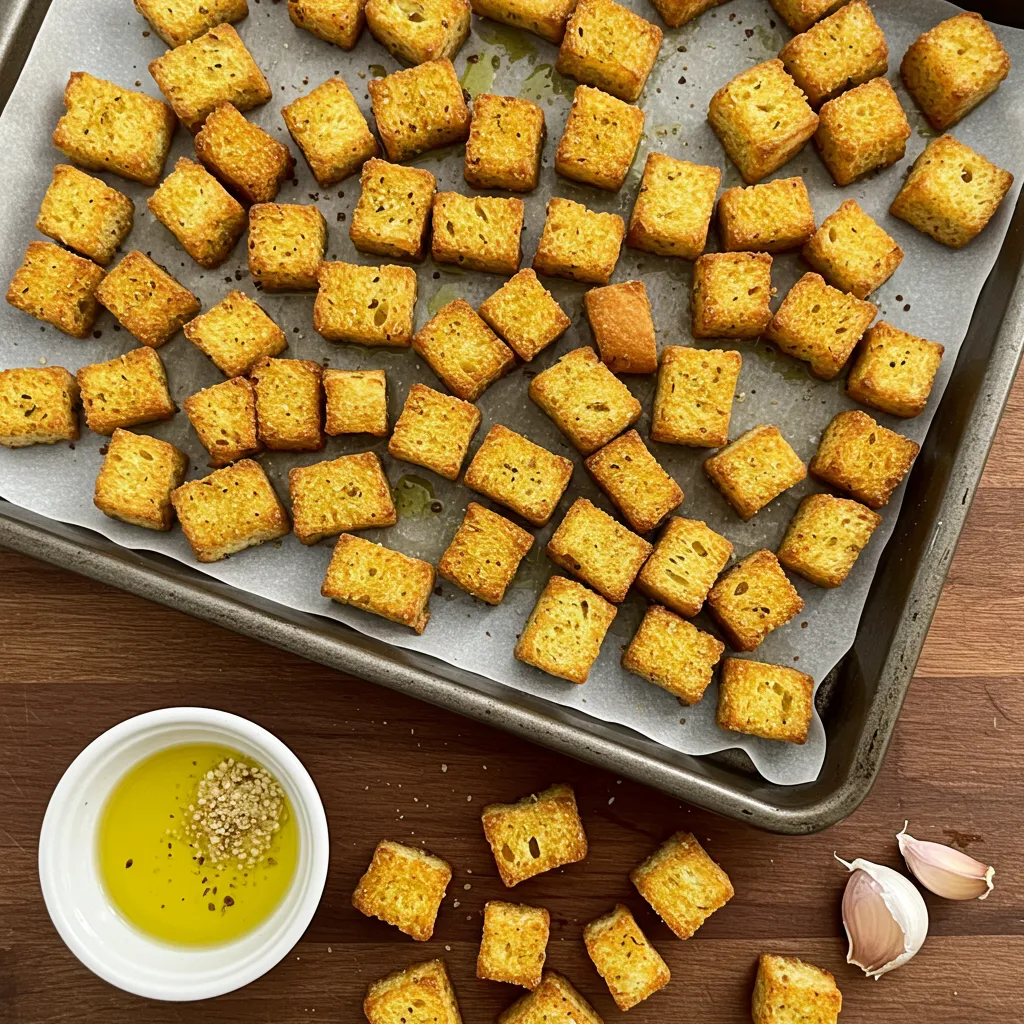
Another key ingredient in a Caesar salad is Parmesan cheese. Parmesan adds depth and richness to the salad. Its sharp, nutty flavor enhances the creamy dressing and provides a savory, salty taste that complements the other ingredients. Freshly grated Parmesan cheese is always preferred, as it has a more intense flavor than pre-shredded cheese, which tends to lack the same richness and aroma.
Some variations of Caesar salad might substitute Parmesan with Pecorino Romano for a sharper taste, but traditional Caesar recipes call for Parmesan. Adding a generous amount of freshly grated cheese on top of the salad just before serving is the perfect finishing touch.
5. Anchovies: The Secret Ingredient
While anchovies might seem like a controversial ingredient, they are an essential part of the classic Caesar salad. Anchovies contribute an undeniable savory depth to the dressing, bringing out a flavor known as umami, which is one of the five basic tastes. They create a subtle but necessary flavor profile that you just can’t replicate with other ingredients.
Some people are hesitant about using anchovies due to their strong flavor, but once combined with the other ingredients in the dressing, they provide an essential richness. If you’re not a fan of whole anchovies, you can use anchovy paste or even skip them altogether, though it will significantly alter the final taste of the salad.
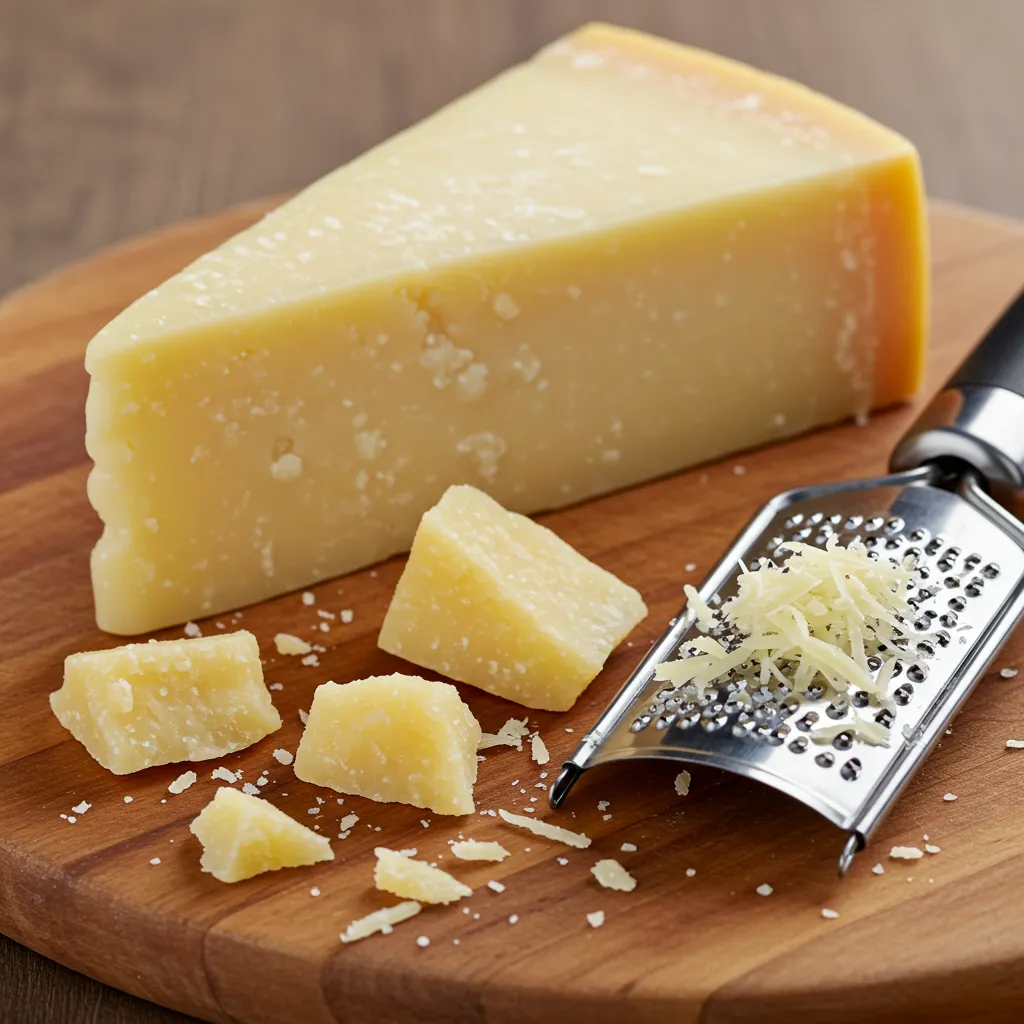
Popular Variations of Caesar Salad
While the classic Caesar salad is the most popular version, there are many variations that people enjoy. Some people add extra ingredients for a more hearty meal, while others opt for different flavors or dietary preferences.
1. Chicken Caesar Salad: A Hearty Option
A Chicken Caesar Salad is a popular variation that turns the classic salad into a main course. Adding grilled chicken to the salad not only increases its protein content but also adds a smoky flavor that pairs perfectly with the creamy dressing. Grilled chicken breast works best, but you can also try other proteins like shrimp or even tofu for a plant-based option.
This variation makes the Caesar salad more filling and substantial, making it a great option for lunch or dinner. For a twist, you can add crispy bacon for a smoky flavor or even avocado for a creamy touch.
2. Vegan Caesar Salad
For those who follow a plant-based diet, a Vegan Caesar Salad offers a great alternative. Instead of eggs and cheese, the dressing is often made with cashews, nutritional yeast, and garlic to mimic the creaminess and savory flavor of traditional Caesar dressing. The anchovies are also omitted, and instead, ingredients like miso paste or seaweed are used to bring in the umami flavor.
In addition to the creamy dressing, the salad can be topped with roasted chickpeas or vegan croutons for added texture. The base of the salad remains romaine lettuce, just like the classic version.
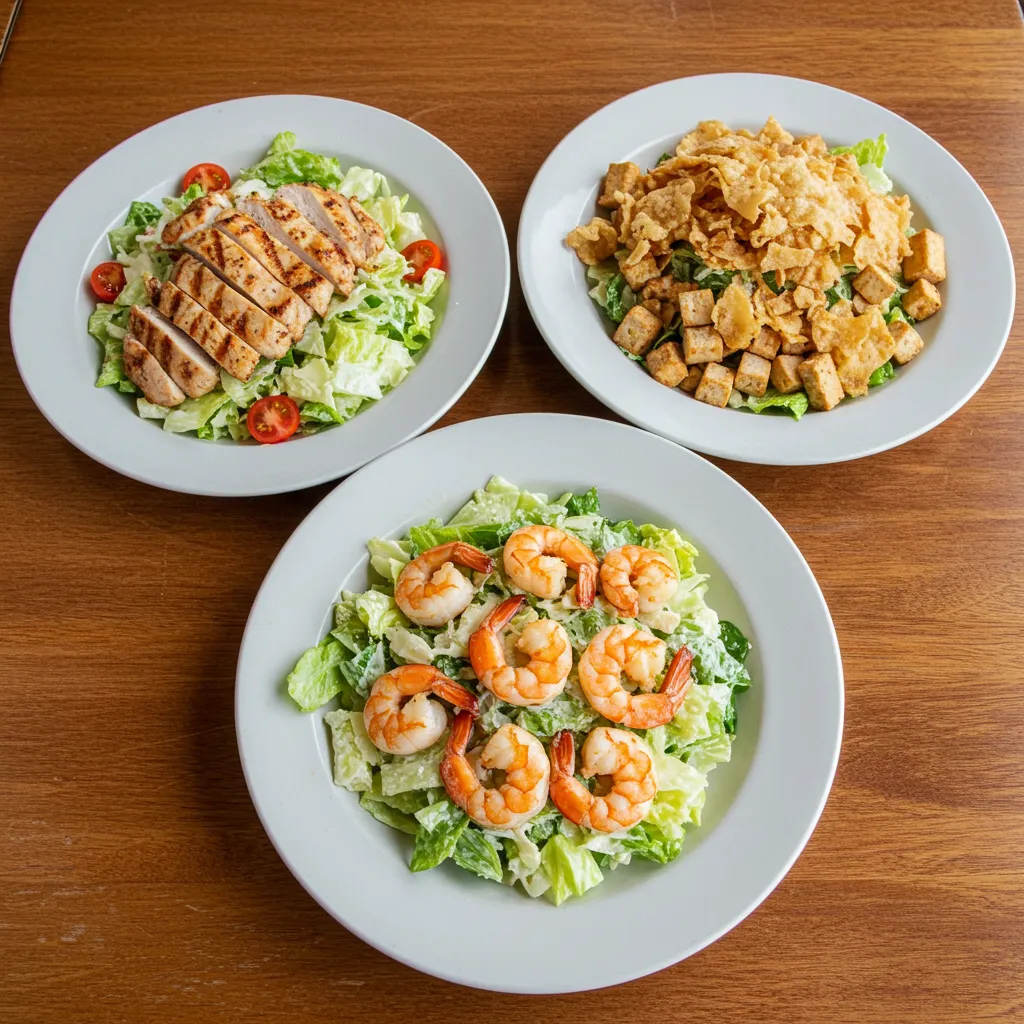
How to Make a Classic Caesar Salad: Step-by-Step
Now that we’ve covered the essential ingredients and popular variations of Caesar salad, let’s go over how to make a classic Caesar salad step-by-step.
1. Making the Dressing
To make the classic Caesar dressing, combine the following ingredients:
- 2 egg yolks
- 2 cloves of garlic, minced
- 1 tablespoon of Dijon mustard
- 1 tablespoon of lemon juice
- 1/4 cup of olive oil
- 3 anchovies or 1 teaspoon of anchovy paste
- 1/4 cup of freshly grated Parmesan cheese
- Salt and pepper to taste
Whisk the egg yolks and mustard together. Gradually add the olive oil while whisking to create an emulsion. Then, add the garlic, anchovies, lemon juice, Parmesan, salt, and pepper. Taste and adjust seasoning as needed.
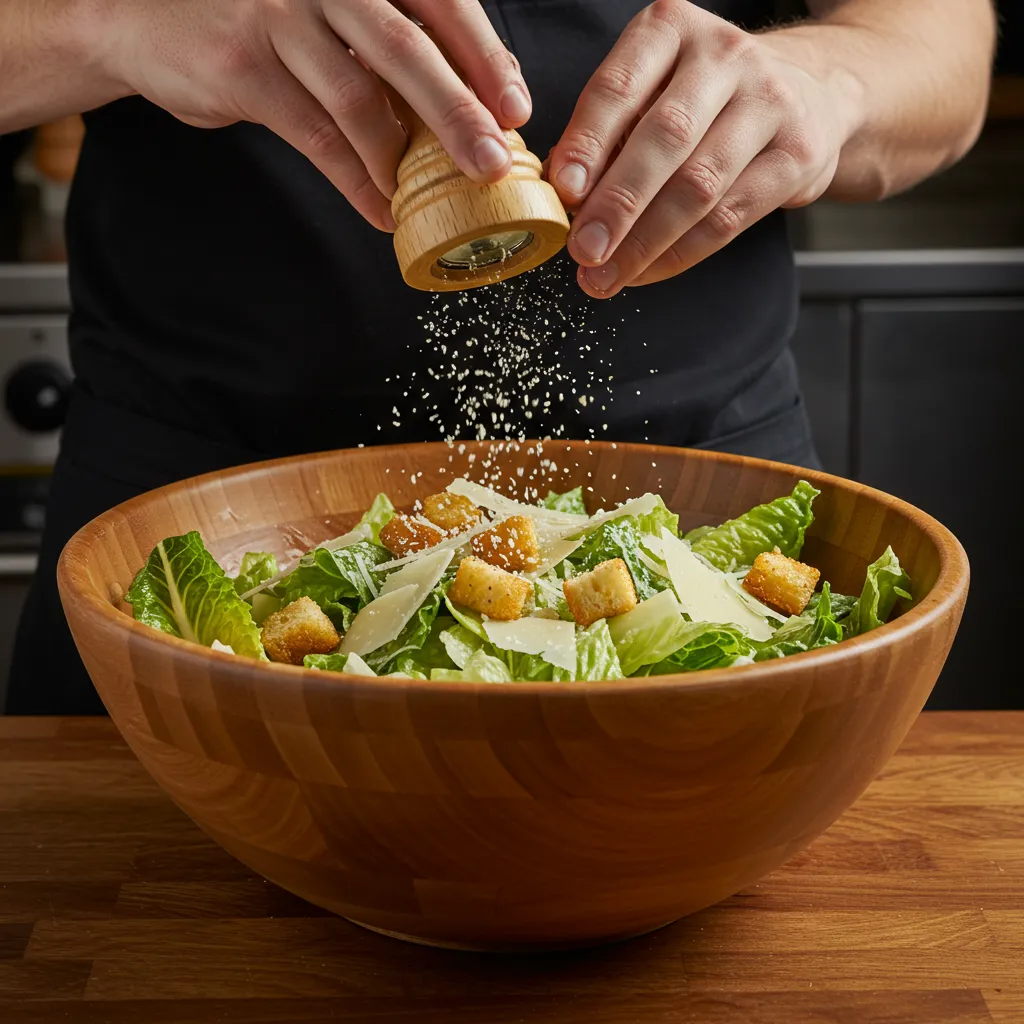
2. Assembling the Salad
To assemble the salad:
- Tear romaine lettuce into bite-sized pieces and place in a large salad bowl.
- Drizzle the Caesar dressing over the lettuce and toss gently to coat.
- Add croutons and toss again.
- Finish with a generous sprinkle of freshly grated Parmesan cheese.
Serve immediately and enjoy the classic flavors of this timeless salad!
Conclusion
A classic Caesar salad is a perfect example of how simplicity and quality ingredients come together to create something extraordinary. By using fresh romaine lettuce, a rich homemade dressing, crunchy croutons, and savory Parmesan cheese, you can enjoy this iconic salad at home. Whether you prefer the traditional recipe or a fun variation like the Chicken Caesar Salad or Vegan Caesar Salad, the possibilities are endless.
This salad is not just a side dish; it can be a meal on its own. Perfect for any occasion, from casual dinners to holiday feasts, the Caesar salad is sure to be a crowd-pleaser. So, gather your ingredients and make a fresh batch of Caesar salad that’s as close to the original as possible!
To explore more topics related to salads, check out the following link:
Learn More About Healthy Fats in Avocado Toast
Anchor Text: “If you’re curious about the health benefits of avocado, check out our post on Is Avocado Toast a Healthy Fat? to learn more about how this trendy dish can be a great source of healthy fats for your diet.
FAQs About Caesar Salad
1. What Makes a Caesar Salad “Classic”?
A classic Caesar salad follows the original recipe created by Caesar Cardini in 1924. It includes romaine lettuce, homemade Caesar dressing, croutons, Parmesan cheese, and anchovies. The key to its signature flavor is the rich, umami-packed dressing made from egg yolks, garlic, lemon juice, Dijon mustard, olive oil, Parmesan, and anchovies.
2. Can I Make Caesar Dressing Without Raw Eggs?
Yes. If you’re concerned about raw eggs, try these alternatives:
- Mayonnaise – Replaces egg yolks while keeping the creamy texture.
- Greek Yogurt – Adds creaminess with a slight tang, making it a lighter option.
- Coddled Egg Yolks – Briefly cooked eggs provide safety while maintaining authenticity.
3. Do I Have to Use Anchovies?
Anchovies are key to the bold umami flavor of Caesar dressing, but you can modify the recipe if you prefer to skip them:
- Anchovy Paste – A milder alternative that blends seamlessly into the dressing.
- Worcestershire Sauce – Contains anchovies but offers a more subtle flavor.
- Miso Paste – A plant-based option that provides a similar depth of taste.
4. How Can I Make the Best Homemade Croutons?
Homemade croutons elevate the texture and taste of your Caesar salad. Follow these simple steps:
- Choose the right bread – Day-old baguette, sourdough, or ciabatta works best.
- Cut into cubes – Aim for even-sized pieces for consistent crunch.
- Season well – Toss with olive oil, garlic powder, salt, and a pinch of black pepper.
- Bake at 375°F (190°C) – Spread on a baking sheet and toast for 10-15 minutes, flipping halfway.
5. What’s the Best Way to Store Caesar Salad?
For the freshest salad, follow these storage tips:
- Dressing: Store separately in an airtight container in the fridge for up to 5 days.
- Lettuce: Keep washed and dried romaine in a sealed bag with a paper towel to absorb moisture.
- Croutons: Store at room temperature in an airtight container to maintain crispness.
- Assembled Salad: Best enjoyed immediately to prevent sogginess.
6. How Can I Add Protein to Make It a Full Meal?
Adding protein transforms Caesar salad into a satisfying entrée. Try:
- Grilled Chicken – A classic pairing with smoky, juicy flavor.
- Shrimp – Light and slightly sweet, perfect for seafood lovers.
- Salmon – Adds healthy fats and a rich taste.
- Tofu or Chickpeas – Great plant-based options for a vegetarian version.
7. Can I Make a Vegan Caesar Salad?
Absolutely. Here’s how:
- Dressing: Swap egg yolks for tahini or cashew cream and use nutritional yeast instead of Parmesan.
- Croutons: Use olive oil instead of butter for a dairy-free option.
- Lettuce & Toppings: Stick with crisp romaine and add roasted chickpeas for extra crunch.
8. How Can I Prevent My Lettuce From Getting Soggy?
Keep your lettuce crisp by:
- Washing and drying it thoroughly before storing. A salad spinner works best.
- Using chilled lettuce for better crunch and freshness.
- Dressing the salad just before serving to prevent wilting.
9. What’s the Secret to a Perfectly Balanced Caesar Dressing?
For a dressing that’s rich but not overpowering:
- Emulsify properly – Whisk egg yolks with mustard before slowly adding olive oil.
- Balance acidity – Lemon juice should enhance, not dominate, the flavor.
- Season gradually – Taste as you go, adjusting salt and anchovies as needed.
10. Can I Meal Prep Caesar Salad?
Yes, but store components separately:
- You can store the dressing in the refrigerator for up to 7 days.
- Lettuce: Pre-washed and stored dry lasts 4-5 days.
- Keep croutons fresh by storing them in an airtight container at room temperature.
- Protein: Cook and refrigerate separately, adding just before serving.
By following these tips, you can enjoy a fresh, restaurant-quality Caesar salad anytime.

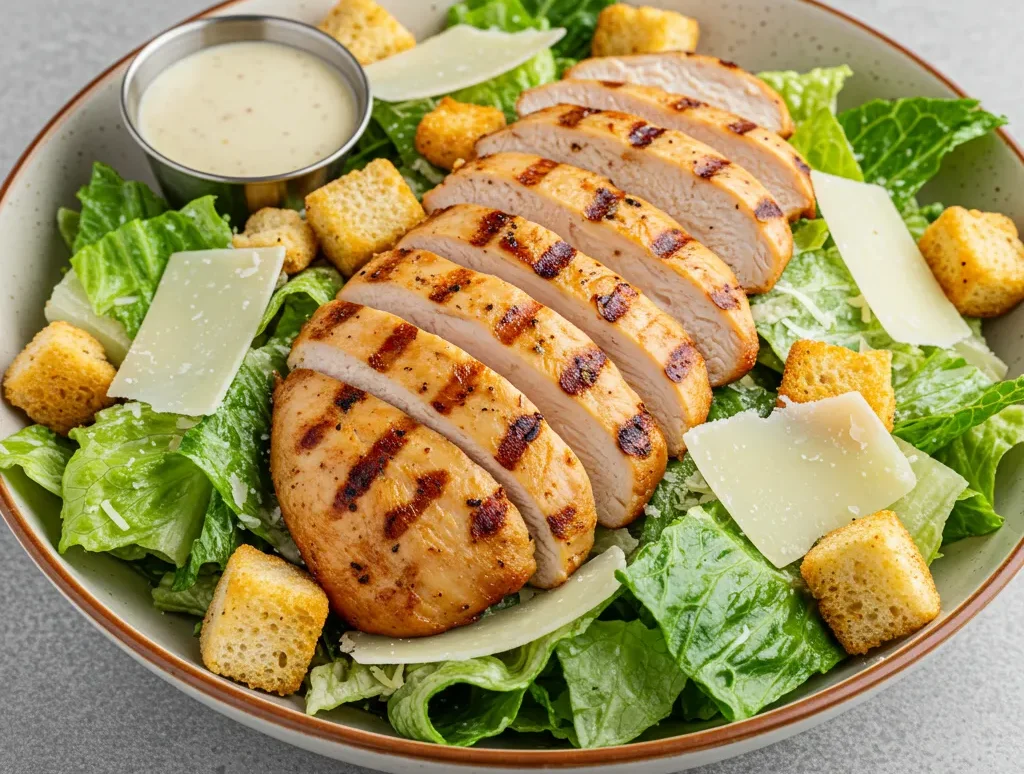
Woww !!!
Very good
Nice recipe